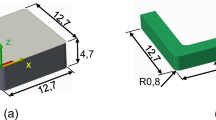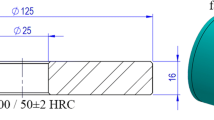Abstract
The determination of the thermal field in a turning process is fundamental to improve the process quality. Recently, the carbide tools have been coated with ceramic materials that present insulating characteristics. This work presents an analysis of the thermal effects of coating in a carbide tool during a turning process using the COMSOL® software and a nonlinear inverse problem. The thermal model consists of a coated carbide tool, a tool holder, and a shim represented by the transient three-dimensional heat diffusion equation with heat loss by convection and radiation. The heat flux, previously unknown, is obtained through the function specification method. In order to validate the methodology, the heat flux is compared with the author’s previous work. Titanium nitride (TiN) and aluminum oxide (Al2O3) are utilized as the coating materials. Both coatings present the expected behavior when less heat is dissipated to the cutting tool substrate. The coated carbide tools present higher temperatures than the uncoated carbide tool in the contact area. The study also found that the thicker the coating, the higher the temperature in the contact area. The results presented in this work may help the development of new long-lasting coated carbide tools.
Similar content being viewed by others
References
Deppermann M, Kneer R (2015) Determination of the heat flux to the workpiece during dry turning by inverse methods. Prod Eng 9:465–471. https://doi.org/10.1007/s11740-015-0635-6
Lazard M, Remy B (2008) Heat flux and temperature estimation during cutting process through regularization technique. In: 5th European Thermal-Sciences Conference. Eindhoven, The Netherlands
Ingraci Neto RR, Scalon VL, Fiocchi AA, Sanchez LEA (2016) Indirect cooling of the cutting tool with a pumped two-phase system in turning of AISI 1045 steel. Int J Adv Manuf Technol 87:2485–2495. https://doi.org/10.1007/s00170-016-8620-6
Liang L, Xu H, Ke Z (2013) An improved three-dimensional inverse heat conduction procedure to determine the tool-chip interface temperature in dry turning. Int J Therm Sci 64:152–161. https://doi.org/10.1016/j.ijthermalsci.2012.08.012
Brito RF, Carvalho SR, Lima E, Silva SMM (2015) Experimental investigation of thermal aspects in a cutting tool using comsol and inverse problem. Appl Therm Eng 86:60–68. https://doi.org/10.1016/j.applthermaleng.2015.03.083
Munoz-Sánchez A, González-Farias IM, Soldani X, Miguélez MH (2011) Hybrid FE/ANN and LPR approach for the inverse identification of material parameters from cutting tests. Int J Adv Manuf Technol 54:21–33. https://doi.org/10.1007/s00170-010-2922-x
De Carvalho SR, Dos Santos MR, De Souza PFB et al (2009) Comparison of inverse methods in the determination of heat flux and temperature in cutting tool during a machining process. High Temp-High Press 38:5–9
Liang L, Quan Y (2013) Investigation of heat partition in dry turning assisted by heat pipe cooling. Int J Adv Manuf Technol 66:1931–1941. https://doi.org/10.1007/s00170-012-4471-y
Brito RF, de Carvalho SR, de Lima E Silva SMM, Ferreira JR (2009) Thermal analysis in coated cutting tools. Int Commun Heat Mass Transf 36:314–321. https://doi.org/10.1016/j.icheatmasstransfer.2009.01.009
Carvalho SR, Lima e Silva SMM, Machado AR, Guimarães G (2006) Temperature determination at the chip-tool interface using an inverse thermal model considering the tool and tool holder. J Mater Process Technol 179:97–104. https://doi.org/10.1016/j.jmatprotec.2006.03.086
Shabgard M, Akhbari S (2016) An inverse heat conduction method to determine the energy transferred to the workpiece in EDM process. Int J Adv Manuf Technol 83:1037–1045. https://doi.org/10.1007/s00170-015-7651-8
Gerlich V, Sulovská K, Zálešák M (2013) COMSOL Multiphysics validation as simulation software for heat transfer calculation in buildings: building simulation software validation. Meas J Int Meas Confed 46:2003–2012. https://doi.org/10.1016/j.measurement.2013.02.020
Greiby I, Mishra DK, Dolan KD (2014) Inverse method to sequentially estimate temperature-dependent thermal conductivity of cherry pomace during nonisothermal heating. J Food Eng 127:16–23. https://doi.org/10.1016/j.jfoodeng.2013.10.039
Suarez V, Hernández Wong J, Nogal U, Calderón A, Rojas-Trigos JB, Juárez AG, Marín E (2014) Study of the heat transfer in solids using infrared photothermal radiometry and simulation by COMSOL Multiphysics. Appl Radiat Isot 83:260–263. https://doi.org/10.1016/j.apradiso.2013.04.010
Grzesik W, Rech J, Zak K (2014) Determination of friction in metal cutting with tool wear and flank face effects. Wear 317:8–16. https://doi.org/10.1016/j.wear.2014.05.003
Jiang F, Zhang T, Yan L (2016) Estimation of temperature-dependent heat transfer coefficients in near-dry cutting. Int J Adv Manuf Technol 86:1207–1218. https://doi.org/10.1007/s00170-015-8293-6
Grzesik W, Niesłony P, Bartoszuk M (2009) Modelling of the cutting process analytical and simulation methods. Adv Manuf Sci Technol 33:5–29
Yuste M, Galindo RE, Sánchez O, Cano D, Casasola R, Albella JM (2010) Correlation between structure and optical properties in low emissivity coatings for solar thermal collectors. In: Thin Solid Films pp 5720–5723, 518 https://doi.org/10.1016/j.tsf.2010.05.056
Wang J, Song B, Zhang X, Song Y, Wu G (2011) Simultaneous measurements of thermal properties of individual carbon fibers. Int J Thermophys 32:974–983. https://doi.org/10.1007/s10765-011-0961-7
Polozine A, Schaeffer L (2005) Exact and approximate methods for determining the thermal parameters of the forging process. J Mater Process Technol 170:611–615. https://doi.org/10.1016/j.jmatprotec.2005.06.041
Bergman TL, Lavine AS, Incropera FP, DeWitt DP (2011) Fundamentals of heat and mass transfer, 7th ed. Wiley, New York
Beck JV, Blackwell B, St Clair, CR Jr (1985) Inverse heat conduction: ill-posed problems, John Wiley and Sons, New York
Acknowledgements
The authors would like to thank CNPq, CAPES, and FAPEMIG for their financial support.
Author information
Authors and Affiliations
Corresponding author
Rights and permissions
About this article
Cite this article
Ferreira, D.C., Magalhães, E., Brito, R.F. et al. Numerical analysis of the influence of coatings on a cutting tool using COMSOL. Int J Adv Manuf Technol 97, 1305–1314 (2018). https://doi.org/10.1007/s00170-018-1855-7
Received:
Accepted:
Published:
Issue Date:
DOI: https://doi.org/10.1007/s00170-018-1855-7




